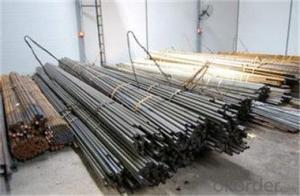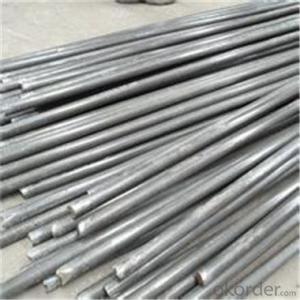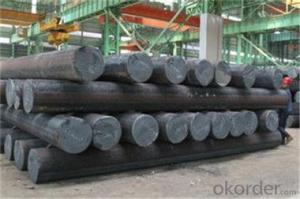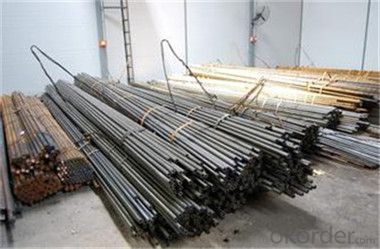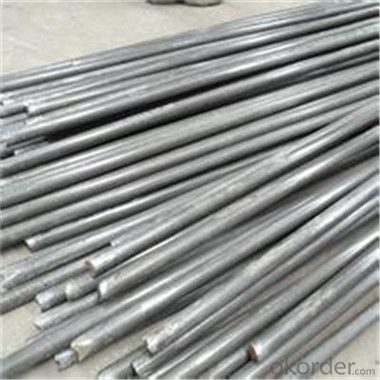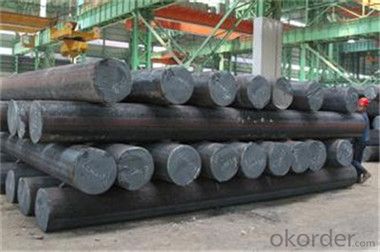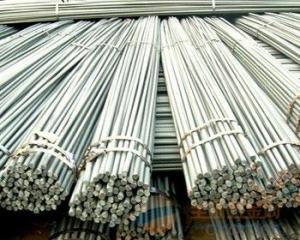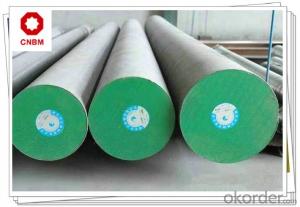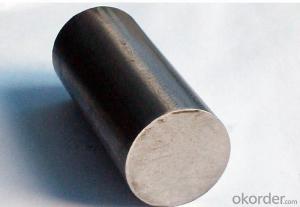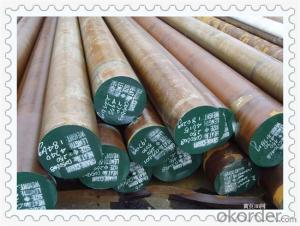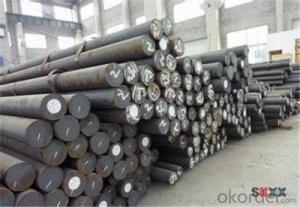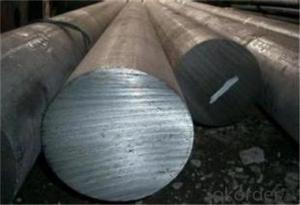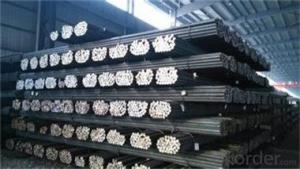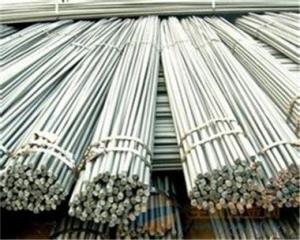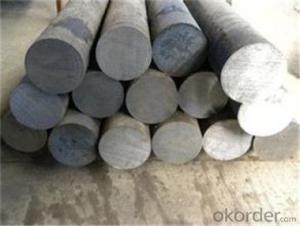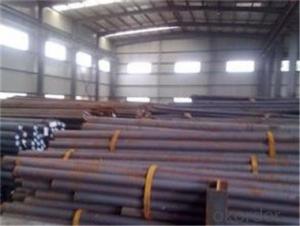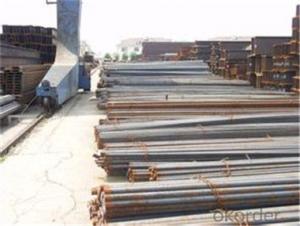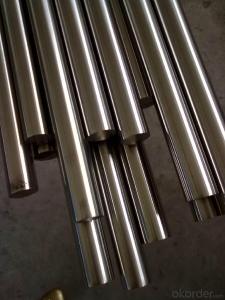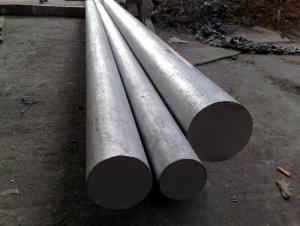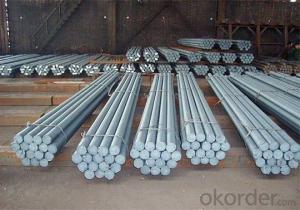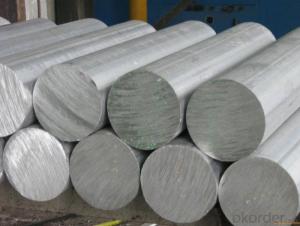Hot Rolled Steel Rod Price Steel Round Bars China
- Loading Port:
- Tianjin
- Payment Terms:
- TT OR LC
- Min Order Qty:
- 776 m.t.
- Supply Capability:
- 2000000 m.t./month
OKorder Service Pledge
OKorder Financial Service
You Might Also Like
Description of steel round bar:
(1) Thickness of not more than 2MM sheet, efficient blanking die, punch die and pressure die etc.
(2) All kinds of scissors, inserts, woodworking blade.
Festures of steel round bar:
1.Dia 80-800mm Length:2000-13000mm or as required
2.Technique:Forged
3.Delivery Time:45 days
Specifications of steel round bar:
The highest temperature is 427 degrees Celsius.it has good strength,and high quenching property ,the toughness is good and small deformation during quenching.At high temperature, there are high creep strength and endurance strength.It is used in the manufacture of a higher strength and higher quenching and tempering section of the 35CrMo steel, like big locomotive traction gears, supercharger drive gear, rear axle, the connecting rod and the spring load greatly clip.
Round bar | Diameter(mm) | Length (mm) | |
10~800 | 2000~5800 | ||
plate/sheet | Thickness(mm) | Width (mm) | Length (mm) |
10~800 | 80~2300 | 2000~5800
|
Images of steel round bar:
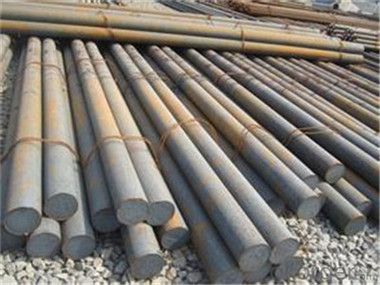
FAQ:
1. What is your package?
Packing situation: standard seaworthy packing or as customer required.
2. How long is the lead time?
Delivery time: 45 days after order confirmed.
- Q: Can steel round bars be used in the aerospace manufacturing industry?
- The aerospace manufacturing industry can indeed utilize steel round bars. In various aerospace applications like structural components, landing gear, engine components, and fasteners, steel round bars are a common choice. The reason behind this is the commendable strength and durability of steel, which makes it highly suitable for critical aerospace applications. Moreover, steel round bars can be conveniently machined and shaped into intricate forms, offering customization and precise engineering solutions in the aerospace sector. Furthermore, steel's ability to resist corrosion and withstand extreme temperatures enhances its reliability in aerospace manufacturing. Ultimately, due to their strength, durability, machinability, and corrosion resistance, steel round bars emerge as a versatile and extensively employed material in the aerospace industry.
- Q: What are the advantages of using non-alloy steel round bars?
- There are several advantages of using non-alloy steel round bars. Firstly, they have excellent machinability, making it easier and more efficient to shape and form them into various components. Secondly, non-alloy steel round bars offer good weldability, allowing for easy joining and fabrication. Additionally, they possess high tensile strength and hardness, making them suitable for applications that require durability and resistance to wear and tear. Furthermore, non-alloy steel round bars are cost-effective compared to alloy steels, making them a preferred choice in industries where budget is a concern.
- Q: Can steel round bars be used for gear applications?
- Yes, steel round bars can be used for gear applications. Steel round bars are often used for manufacturing gears due to their high strength, durability, and ability to withstand heavy loads and wear. They can be machined and heat-treated to meet specific gear requirements, making them a suitable choice for various gear applications in industries such as automotive, machinery, and manufacturing.
- Q: What are the advantages of using nickel-tin alloy steel round bars?
- Nickel-tin alloy steel round bars offer numerous benefits. Firstly, their corrosion resistance is excellent, making them perfect for use in harsh environments and with corrosive substances. The addition of nickel and tin enhances their durability and longevity, enabling them to withstand prolonged exposure to moisture, chemicals, and other corrosive elements. Secondly, these round bars provide superior strength and toughness. The combination of nickel and tin in their alloy composition improves their mechanical properties, making them highly resistant to deformation, bending, and breaking. As a result, they are suitable for demanding applications in industries such as construction, aerospace, and automotive. Additionally, nickel-tin alloy steel round bars exhibit exceptional heat resistance. They can endure high temperatures without significant loss of strength or deformation. This makes them ideal for applications involving exposure to elevated temperatures, such as in furnaces, boilers, and heat exchangers. Moreover, nickel-tin alloy steel is renowned for its excellent electrical conductivity. This property makes the round bars suitable for applications requiring efficient electrical transmission, such as in electrical wiring, power generation, and electrical equipment manufacturing. Lastly, machining and fabricating nickel-tin alloy steel round bars is relatively easy. They can be shaped, cut, and welded with ease, allowing for versatility in various manufacturing processes. This ease of machining and fabrication ensures efficient production and reduces overall manufacturing costs. In conclusion, the advantages of using nickel-tin alloy steel round bars include outstanding corrosion resistance, superior strength and toughness, high heat resistance, excellent electrical conductivity, and ease of machining and fabrication. These properties make nickel-tin alloy steel round bars the preferred choice for a wide range of applications in diverse industries.
- Q: Can steel round bars be used for making fasteners?
- Certainly! Fasteners can indeed be made using steel round bars. Manufacturers commonly utilize steel round bars to produce fasteners like bolts, screws, and rivets. The strength and durability of steel make it an excellent choice for fasteners, as it can endure significant stress and ensure a secure connection. Moreover, steel round bars can be conveniently machined and threaded to achieve the desired shape and size required for fasteners. In summary, steel round bars are highly dependable and frequently employed in the manufacturing process of fasteners.
- Q: Is there a steel bar of 6 diameter on the market?
- Including round steel bar, ribbed steel bar and twisted steel bar. Steel bars for concrete reinforcement is straight or strip steel plate reinforced concrete reinforcement steel, its shape is divided into round steel bar and deformed steel two, straight and coiled state for delivery two.
- Q: How do you calculate the weight of a steel round bar?
- To calculate the weight of a steel round bar, you can use the formula: Weight = (Diameter^2 / 4) * Length * Density In this formula, the Diameter refers to the diameter of the round bar, Length represents the length of the bar, and Density is the density of the steel material. First, you need to measure the diameter of the steel round bar accurately. Then, square the diameter by multiplying it by itself. Divide the result by 4. This will give you the cross-sectional area of the round bar. Next, multiply the cross-sectional area by the length of the bar. Finally, multiply this value by the density of the steel material. The density of steel is typically around 7850 kg/m^3. The result of this calculation will give you the weight of the steel round bar in grams or kilograms, depending on the units used for the length and density.
- Q: What is the difference between a centerless ground and a hot rolled steel round bar?
- A centerless ground steel round bar and a hot rolled steel round bar are two different types of steel bars with distinct characteristics. Firstly, the manufacturing process for each type differs. A centerless ground steel round bar is produced by passing the steel bar through a centerless grinder, which removes any surface imperfections and creates a precise and smooth finish. This process ensures the bar has tight tolerances and consistent diameter throughout its length. On the other hand, a hot rolled steel round bar is created by heating the steel billet at extremely high temperatures and then rolling it through a series of mills to achieve the desired shape and size. This process results in a rougher surface finish compared to centerless ground steel bars. In terms of physical properties, centerless ground steel bars typically have a higher level of dimensional accuracy and straightness due to the precision grinding process. This makes them suitable for applications where tight tolerances and precise measurements are required, such as in the manufacturing of machinery parts or precision tools. Hot rolled steel round bars, on the other hand, are known for their strength and durability. The heating and rolling process imparts desirable mechanical properties to the steel, such as increased hardness and toughness. These bars are commonly used in general construction, structural applications, and fabrication projects where strength and reliability are crucial. In summary, the main difference between a centerless ground and a hot rolled steel round bar lies in their manufacturing processes, surface finish, and intended applications. While centerless ground bars offer superior dimensional accuracy and smoothness, hot rolled bars are valued for their strength and resilience. The choice between the two depends on the specific requirements of the application at hand.
- Q: What are the different types of steel used in round bars?
- There are several different types of steel that are commonly used in the production of round bars. Some of the most common types include: 1. Carbon Steel: This is the most basic type of steel used in round bars. It contains a small amount of carbon (typically less than 1%) and is known for its strength and durability. Carbon steel is often used in construction and structural applications. 2. Alloy Steel: Alloy steel is made by adding other elements to carbon steel, such as manganese, chromium, or nickel. These additional elements enhance the strength, hardness, and corrosion resistance of the steel. Alloy steel round bars are commonly used in machinery and automotive parts. 3. Stainless Steel: Stainless steel is a type of steel that contains a minimum of 10.5% chromium by mass. This high chromium content gives stainless steel its unique properties, including corrosion resistance and a shiny appearance. Stainless steel round bars are widely used in the food industry, construction, and in applications where high corrosion resistance is required. 4. Tool Steel: Tool steel is a special type of steel that is designed to withstand high temperatures and resist wear and tear. It is commonly used in the manufacturing of tools and dies, as well as in applications where high strength and hardness are necessary. 5. Duplex Stainless Steel: Duplex stainless steel is a type of stainless steel that contains a combination of austenite and ferrite phases in its microstructure. This gives it superior strength and corrosion resistance compared to regular stainless steel. Duplex stainless steel round bars are often used in marine and chemical industries. Overall, the choice of steel for round bars depends on the specific requirements of the application, such as strength, corrosion resistance, and temperature resistance.
- Q: What are the different types of steel round bar surface treatments for improved wear resistance?
- Some common types of steel round bar surface treatments for improved wear resistance include heat treatment, such as carburizing or nitriding, which introduces a hardened layer on the surface of the bar. Other options include coating the surface with materials like chrome or nickel to enhance durability. Additionally, shot peening is a process that bombards the surface with small metallic or ceramic particles to create compressive stress and improve resistance to wear.
Send your message to us
Hot Rolled Steel Rod Price Steel Round Bars China
- Loading Port:
- Tianjin
- Payment Terms:
- TT OR LC
- Min Order Qty:
- 776 m.t.
- Supply Capability:
- 2000000 m.t./month
OKorder Service Pledge
OKorder Financial Service
Similar products
Hot products
Hot Searches
Related keywords
